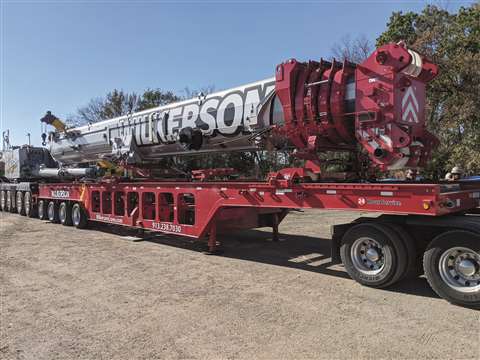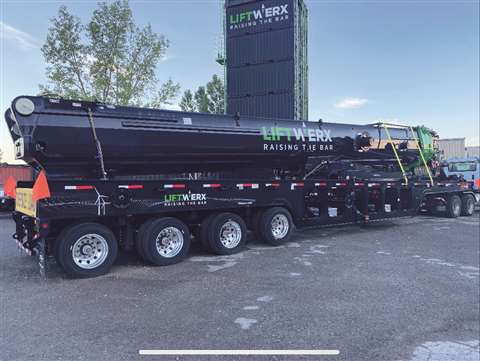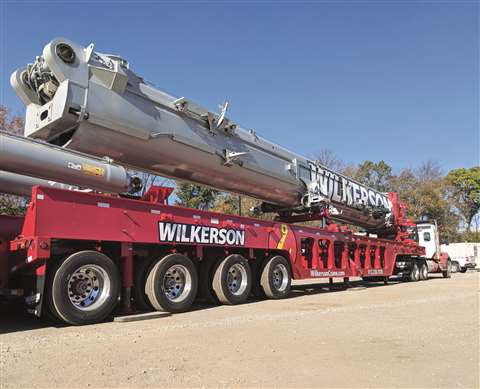What are the benefits of a boom launch trailer?
03 April 2023
For the most part, large-scale all terrain cranes were designed to travel over the road. But the really big ones are often too heavy to be permitted for over the road travel.
 TransWorld Manufacturing and Nelson Manufacturing are unveiling new boom launch products this year.
TransWorld Manufacturing and Nelson Manufacturing are unveiling new boom launch products this year.
There are three solutions: use a boom dolly to spread out the weight of the boom over a larger area, use a crane to remove the boom from the crane and transport the boom on an overflow trailer or use a boom launch trailer.
Taking the boom out of a large-scale all-terrain crane is not for the faint of heart. Mobilizing and demobilizing an all-terrain crane requires distinctive know-how, and up until about 25 to 30 years ago, required an assist crane to lift the boom out of the crane and move it to a trailer for travel.
The boom launch trailer was a rarity in the market until a few years ago. Essentially, a boom launch trailer provides a means for a user to be able to remove and install the boom into a larger all-terrain crane without an assist crane.
“This creates significant cost savings,” said Tony Niese, president of Nelson Manufacturing.
He said that by removing the assist crane from the equation, the following tasks are removed from the project:
- Transport of the assist crane to the jobsite which can often be a 100 to 140-ton machine.
- Counterweight trucks and transport to the jobsite.
- Set up of the assist crane.
- Rigging hardware for handling of the larger crane boom.
- Tear down of the assist crane.
- Counterweight trucks and transport from the jobsite back to the yard.
- Transport of the assist crane back to the yard.
“Customers can set up and launch a crane boom in 30 to 40 minutes,” said Niese. “Besides being able to do the job with fewer people, they can do it quicker. Especially these days with a lack of trained personnel, anytime you can do more with less people that is a huge win.”
A boom launch trailer also frees up the assist crane to do other work.
Crystal Dieleman, president of TransWorld Manufacturing Company, explained that large mobile cranes are too heavy to drive in most places in North America.
“The crane must be broken down to transport, so the boom may need to be removed to make weight,” she said. “Boom launch trailers are a level up from boom dollies, where we flip the boom over the back and drive with the boom weight displaced.”
Quicker boom launch
“Launchers offer the crane company the ability to efficiently transport their crane to and from a jobsite, and the “launch” part of the trailer will install or remove the crane’s boom to or from the crane carrier,” Dieleman said.
“If the crane company used a regular trailer (instead of a launch), they would also have to send an assist crane to install the cranes boom,” she said. “Depending on the state laws and the assist crane that is needed and available, that assist crane could also require a couple truck loads to mobilize. So, in total, it’s just a much more efficient way to mobilize, removing a crane and one or more truckloads from the mobilization process.”
 The new Nelson BLXLT line of boom launch trailers will debut at ConExpo 2023.
The new Nelson BLXLT line of boom launch trailers will debut at ConExpo 2023.
Both Niese and Dieleman are optimistic about the market for boom launchers.
“It’s growing,” said Dieleman. “Larger all terrains seem to be in demand. I think the infrastructure bill, and continued focus on wind and renewable energy, is making these large cranes a necessary purchase for the companies that want to compete for these projects.”
Dieleman said her company is seeing the most demand in the 500-plus-ton capacity all-terrain cranes, and in smaller cranes in more transportation-restricted areas.
“If your crane has eight axles or more, you probably need to launch,” she said.
Demand for boom launch trailers has been “very good,” Niese said.
“We have recently seen a bit of a slowdown in demand, however, there continues to be considerable interest” he said. “We expect demand to grow as large AT cranes become more readily available.”
What tonnage are boom launch trailers utilized for?
Or the most part, boom launch trailers are in play when dealing with all terrain cranes in the 400 to 700-ton capacity range.
“The Nelson boom launch trailer is an effective tool for crane companies,” Niese said. “With proper training, an all-terrain crane boom can be removed and reinstalled into a crane efficiently and safely.”
The boom launch trailer got its start in the early 1990s when Martin Inc. asked Nelson Manufacturing to develop a method to eliminate the assist crane on one of its all terrain cranes, according to Niese.
“After a considerable amount of back and forth with the customer and the crane manufacturer, our first design was developed,” he said. “Once the trailer was completed, we spent some time working with the crane and the trailer to get it to work more efficiently.”
After a couple of iterations, Niese said the first boom launch trailer was born.
 By removing the assist crane from the equation, time and money are saved. Boom launch trailers mean fewer personnel are required on the jobsite, and the assist crane can generate revenue on another job.
By removing the assist crane from the equation, time and money are saved. Boom launch trailers mean fewer personnel are required on the jobsite, and the assist crane can generate revenue on another job.
“While this first boom launch trailer was functional and safe it was not nearly as efficient as the launch trailers that we build today,” he said. “The first boom launch was not exactly a market success as it took us several years to actually sell another one.”
In the early 2000s, the Nelson team came up with new a new boom launch trailer design. Niese said it was a self-contained trailer that provided the hydraulics, mechanical attachments and everything needed to “launch” the boom.
“Once this new design hit the market we began to see quick growth in their popularity,” Niese said.
The Nelson team works with all the major crane manufacturers to ensure that the way launch trailer handles the boom can be done so properly without putting an undue stress in the boom, Niese said.
“Many all-terrain cranes can be ordered with a Nelson Boom Launch Kit, ensuring that any boom launch interface points are included on the boom right from the crane manufacturer,” Niese said. “Depending on the manufacturer, this will also include hydraulic pin pullers, luffing cylinder supports and quick disconnects for the hydraulic and electrical lines.”
For the most part, a boom launch trailer is a niche product, Dieleman said. While it may be considered an expensive tool, it can easily pay for itself, saving labor and equipment costs for the lifetime of the larger scale all-terrain crane.
“When I try to explain what a launch is to my non-industry friends, I point out that we’re talking about cranes that are so large they need other cranes to mobilize them,” she said. “Crane rental is the core business, so we need to get creative because it seems silly to buy a dedicated crane to build up another crane when it should be rented out to other customers.”
A new boom launch trailer debut
TransWorld Manufacturing will be unveiling a new boom launch trailer to market later this year, according to Dieleman.
“It’s a brand new take on an old concept,” she said. “We have spent years completely developing this product from the ground up. We spent a lot of time with users of existing boom launches and took their comments and ideas into consideration to create a new product that streamlines the user experience, maximizes transport efficiency and is more versatile than anything else currently offered.”
After many years of research, design and analysis, TransWorld’s design is still under wraps.
“We are keeping the build close to the vest until we have a few out in the wild,” she said.
Nelson Manufacturing will be unveiling a new boom launch trailer, the BLXLT, at ConExpo this month in Las Vegas.
“This new completely reimagined boom launch trailer comes in at a whopping 8,000 pounds less weight than Nelson’s standard BL models,” Niese said. “Self-contained power units, hydraulic levelling legs, side shift capabilities and an overall robust design are standard.”
STAY CONNECTED


Receive the information you need when you need it through our world-leading magazines, newsletters and daily briefings.



